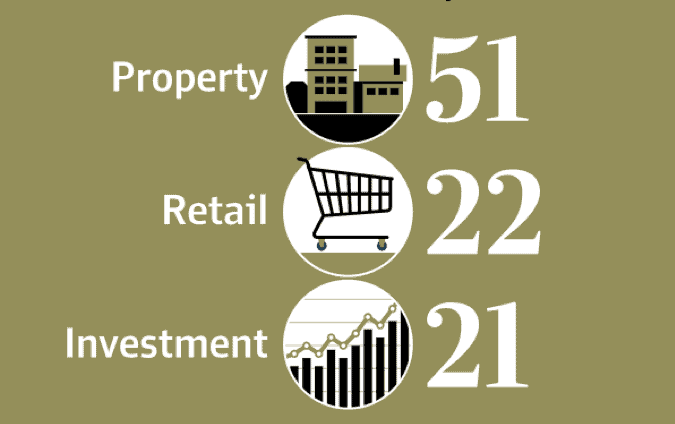The property boom has once again propelled developers to The Australian Financial Review 2018 Rich List. Despite a slowdown in the property market, real estate tycoons dominate the list, with 51 of Australia’s 200 wealthiest acquiring most of their fortunes in the property sector.
Together, property rich listers have a combined wealth of $86.2 billion. Harry Triguboff, Managing Director of Meriton, leads this group. He is second on the Rich List, with a fortune of $12.77 billion, up from $11.45 billion in 2017.
Figure 1: Number of Australian rich listers in the dominant industries

The number of property developers on the Rich List has, however, fallen from 58 in 2017 to 51 this year. Increased wealth from the technology industry has posed some competition for rich listers in traditional wealth-creating industries such as property, resources and manufacturing. Australia’s wealthiest technology entrepreneurs, Atlassian co-founders Mike Cannon-Brookes and Scott Farquhar, have more than doubled their wealth from $2.5 billion each in 2017 to $5.16 billion each this year, moving them up to 11th and 12th spots, respectively, in the rankings.
Figure 2: Australia’s 20 wealthiest individuals, 2018
| Rank | Rich lister | Wealth (billions) | Industry |
| 1 | Anthony Pratt and family | $12.90 | Manufacturing |
| 2 | Harry Triguboff | $12.77 | Property |
| 3 | Gina Rinehart | $12.68 | Resources |
| 4 | Hui Wing Mau | $9.09 | Property |
| 5 | Frank Lowy | $8.42 | Property |
| 6 | Ivan Glasenberg | $8.32 | Resources |
| 7 | John Gandel | $6.45 | Property |
| 8 | Andrew Forrest | $6.10 | Resources |
| 9 | Vivek Sehgal | $5.88 | Manufacturing |
| 10 | James Packer | $5.25 | Gaming |
| 11 | Mike Cannon-Brookes | $5.16 | Technology |
| 12 | Scott Farquhar | $5.16 | Technology |
| 13 | Kerry Stokes | $4.93 | Media |
| 14 | Len Ainsworth and family | $4.02 | Manufacturing |
| 15 | Stan Perron | $3.99 | Property |
| 16 | Alan Wilson and family | $3.87 | Retail |
| 17 | Lindsay Fox | $3.56 | Transport |
| 18 | Lang Walker | $3.47 | Property |
| 19 | Bianca Rinehart | $3.28 | Resources |
| 20 | Clive Palmer | $2.84 | Resources |
Still, many of this year’s rich listers – including the five wealthiest individuals – have acquired most of their wealth from traditional industries.
Steady internationalisation
A more distinct difference from previous years in the makeup of the rich list is its internationalisation, which the AFR described as “a slow but steady change”. This year’s wealthiest person, paper manufacturing and recycling tycoon Anthony Pratt, has seen his fortune surge, largely due to his company’s rapid growth in the US, according to the AFR.
Other homegrown billionaires who have increased their wealth through exports or overseas business operations include mining mogul Gina Rinehart and toy manufacturer Manny Stul. Rinehart’s Roy Hill mine exports more than 50 million tonnes of iron ore annually, and her recently launched 2GR Premium Wagyu Beef ships frozen beef to China. Stul’s Moose Toys was the fifth-largest toy manufacturer in both Australia and the US in 2016.
A growing number of Australia’s richest are also based overseas. “Ten years ago, when we celebrated 25 years of what was then the BRW Rich List, just one of Australia’s 34 billionaires lived overseas,” says the AFR. “Today, in 2018, about one-quarter of our billionaires live offshore.” Chinese-born real estate developer Hui Wing Mau is the wealthiest Australian living overseas. He ranks fourth on the Rich List and 22nd on Forbes’ China’s Richest 2017.
The rich are becoming richer
Sixteen people became billionaires this year, according to the AFR Rich List, bringing the total number of Australian billionaires to 76.
The increase in wealth of those on the list lifted the cut-off, or minimum wealth, from $342 million in 2017 to $387 million this year, leading to the exclusion of famous names such as actress Nicole Kidman and Temenos founder George Koukis.
“It’s not a case of wealth in decline, more so that others have become a lot richer,” says the AFR.




